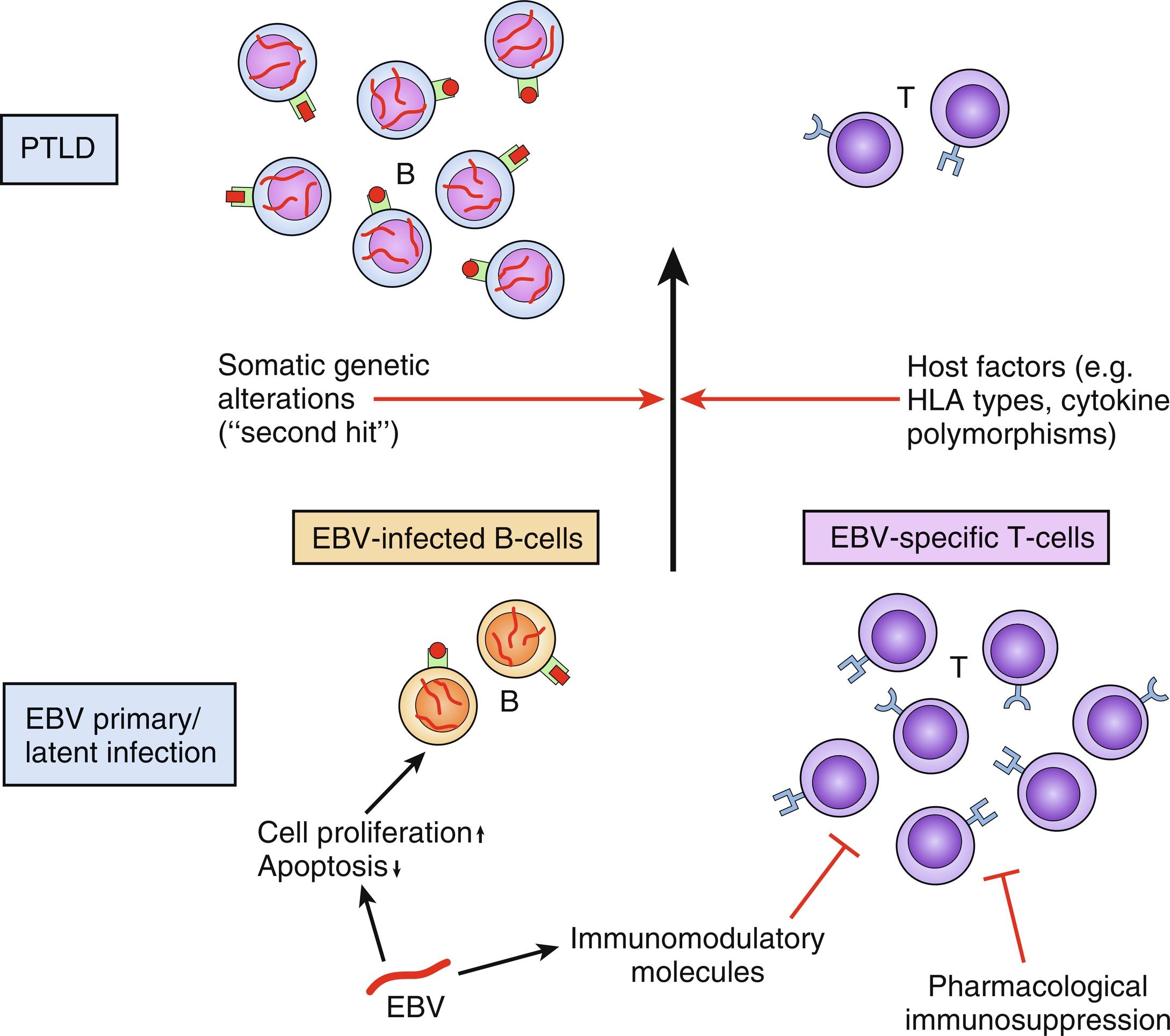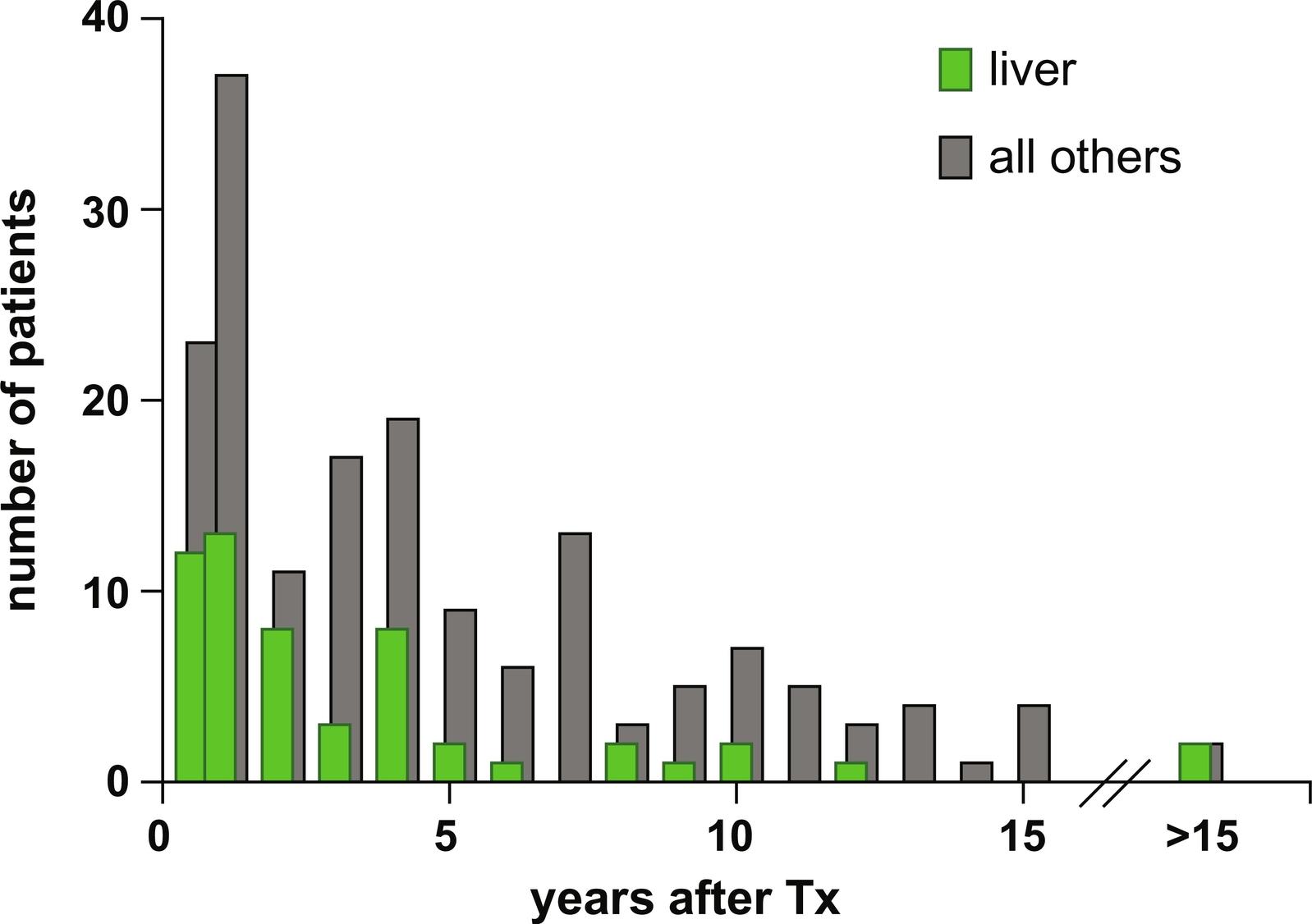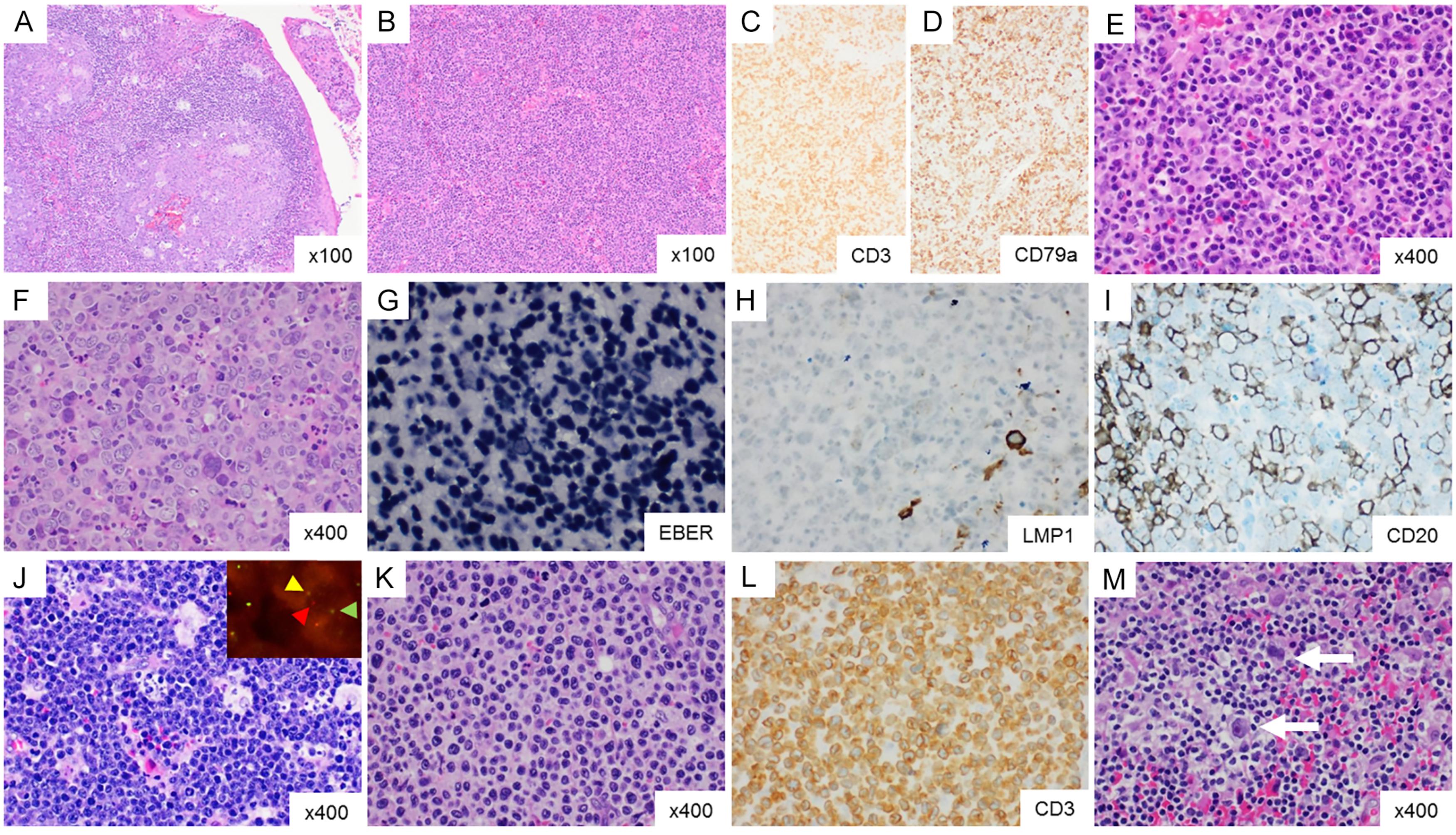Physical Address
304 North Cardinal St.
Dorchester Center, MA 02124
Post-transplant lymphoproliferative diseases (PTLDs) are the most frequent malignant disorders after solid-organ transplantation in children. Although morphologically often indistinguishable from de novo lymphomatous diseases, per definition, every lymphoproliferation arising after transplantation is considered a PTLD. Because pathogenesis in the context of immunosuppression, viral infection, and treatment differ from lymphomas in immunocompetent patients, PTLD needs to be considered as its own disease entity. Thus the World Health Organization (WHO) recognizes PTLD as a separate group of lymphomas with distinct subclassifications.
The pathophysiology of PTLD is only partially understood, and its cause is most probably multifactorial ( Fig. 28.1 ). Despite all uncertainties, Epstein-Barr virus (EBV) infection (and/or reactivation) and immunosuppression necessary to maintain graft tolerance are unquestioned elements of post-transplant lymphomagenesis.

Epstein-Barr virus (EBV; human herpesvirus 4 [HHV-4]) is a human oncovirus belonging to the group of gamma herpesviruses. Primary infection with EBV usually occurs during childhood or adolescence, and by the age of 30 years, more than 90% of the population have acquired a persistent latent EBV infection of B cells. In addition, EBV can persist in salivary gland ductal cells. EBV particles are transmitted in the saliva fluid and use complement component 3d/EBV receptor 2 (CD21) for infecting B cells. Following B-cell infection, EBV establishes a nonproductive (latent) infection that is divided into four types—latency types 0 to 3—characterized by distinct viral gene expression profiles. On specific stimulation, EBV may switch into a productive (lytic) mode of infection, in which viral progeny is produced by the infected cell. EBV encodes latent membrane proteins (LMPs), Epstein-Barr nuclear antigens (EBNAs), other proteins, and regulatory noncoding RNA molecules, such as EBV-encoded small RNA (EBER), whose expression depends on the latency type of EBV infection.
In vitro EBV infection of B cells results in the outgrowth of immortalized lymphoblastoid B-cell lines, which express the latency type III program. This so-called growth program is characterized by the expression of nine proteins, LMP1, isoforms LMP2A and LMP2B as well as six EBNAs. These mimic external growth signals and inhibit apoptosis (LMP1 and LMP2A) or directly regulate gene expression (EBNA2, EBNA3c), thereby driving the infected cell into proliferation. In type II latency (default program), EBV gene expression is limited to the LMPs and EBNA1. EBV here supplies the infected B cell with signals, which are usually received on antigen contact in the germinal center. These signals drive the infected cell toward the memory B-cell stage. In type I latency, only EBNA1 , a gene required to maintain the viral genome during mitosis, is expressed. In latency type 0, no EBV protein is expressed in the infected cell.
EBV-infected B-cells normally induce strong EBV-specific CD8 + and CD4 + T-cell responses, which control the proliferation of infected B cells in vitro and in vivo . The T-cell response is directed against a broad set of viral gene products expressed during the latent and lytic cycles of EBV. Pharmacological immunosuppression leads to impaired T-cell responses in vivo and therefore greatly increases the risk of uncontrolled B-cell proliferation. It is not entirely clear which T-cell populations confer protection against lymphoma development, but animal studies point to the importance of CD4 + T cells. Clinical success using transfer of EBV-specific T cells have indicated that latent antigens (EBNA1-3, LMP2) are targets of protective immune responses.
Despite its unquestionable role, EBV infection alone may not be sufficient to induce PTLD in all cases. EBV plays a pivotal role, especially in early PTLD development, during the first post-transplantation year. Under continued immunosuppression, cells displaying other genetic alterations may escape immunosurveillance, and oncogenic mutations drive PTLD development. Some characteristic mutations (e.g., c-MYC translocations in Burkitt lymphoma or Burkitt PTLD ) have been detected in EBV-positive (EBV +) and EBV-negative (EBV-) monomorphic PTLD patients. Other cytogenetic defects involve chromosome segments 1q11-21, 14q32, 16p13, 11q23-24, and 18q21 in high-grade B-cell lymphoma PTLD. Upregulation of BCL2 (18q21) and BCL6 (3q27) are typical defects. Recently, several genetic alterations have been detected in T- and natural killer (NK)-cell PTLD, including inactivating mutations of deletions or the tumor suppressor gene TP53 (17p13). If and how these genetic alterations collaborate with EBV in B-cell transformation and lymphomagenesis remains unknown. Recent studies focus on gene expression patterns of different PTLD subtypes and the microenvironment (summarized by Morscio and Tousseyn ).
Most cases of PTLD in recipients of solid organ transplantation are derived from recipient cells. However, especially after liver transplantation (LT), donor-derived PTLDs account for a significant proportion, possibly because of the transplantation of large amounts of donor B cells with the graft. A short tandem repeat (STR) polymerase chain reaction (PCR) assay or, if applicable, XY chromosome analysis, can easily reveal the origin of the PTLD. Donor-derived PTLDs seem to involve the graft organ preferentially.
In principle, all PTLD subtypes can manifest at any time after transplantation, even after a few weeks or many years. However, there are two clusters of PTLD onset—during the first year after transplantation (30%-40%, termed early PTLD ) and thereafter with an accumulation during the third to fourth post-transplantation year ( Fig. 28.2 ; data from the German Ped-PTLD registry). Early PTLD is almost exclusively EBV-driven and manifests as polymorphic or classic B-cell PTLD, whereas Burkitt lymphoma or classic Hodgkin disease PTLD is a late event after transplantation.

PTLDs are grouped as a separate entity in the 2016 revised WHO classification of lymphoid tumors ( Table 28.1 ). Nondestructive PTLD (formerly termed early-lesion PTLD ) are morphologically indistinguishable from reactive lymphoproliferation in nontransplanted patients. Whereas polymorphic PTLDs are only found in immunocompromised patients, lymphomas from the monomorphic PTLD group are morphologically and genetically indistinguishable from their counterparts in immunocompetent individuals.
| Type | Features |
|---|---|
| Nondestructive post-transplant lymphoproliferative disease (PTLD) (former early lesion) | Plasmacytic hyperplasia, infectious mononucleosis - like PTLD, fluoride follicular hyperplasia |
| Polymorphic PTLD | B-cell origin, T-cell origin |
| Monomorphic PTLD | Aggressive B-cell type
T-cell, natural killer cell type |
| Classic Hodgkin lymphoma PTLD | CD15 +, CD30 + |
Tissue sampling for histology, immunohistochemistry, EBER in situ hybridization (ISH), PCR analysis of clonality, and fluorescence in situ hybridization (FISH) is mandatory for diagnosis. In principle, EBV-negative PTLD and EBV reactivation can coexist. Therefore, only direct detection of EBER by ISH or EBV proteins by immunohistochemistry in the tumor cells proves EBV association, but serum detection of EBV per se does not allow an EBV + PTLD to be found definitively.
Regarding PCR, the following pitfalls should be taken into account: (1) technical pseudomonoclonality because of a small amount of analyzed cells (e.g., biopsy specimen); (2) technical pseudopolyclonality because of hypermutation of the corresponding immunoglobulin (immunoglobulin heavy chain, IgH) or T-cell receptor (TCR) gene segments (i.e., PCR primers can no longer bind to the altered DNA sequence but detect the polyclonal background); and (3) transient dominant proliferation of one clone or oligoclonality.
Pitfalls of FISH analysis can be few tumor cells intermingled in a background of predominant reactive cells, such as lymphocyte-rich large B-cell lymphoma PTLD or masked tumor cells because of superimposed granulocytic inflammation and/or necrosis. FISH is usually not helpful for discriminating nondestructive PTLD from other types of PTLD.
Nondestructive PTLDs ( Fig. 28.3 A ) form masses, which histologically consist of follicular lymphatic hyperplasia, typically with increased number of plasma cells with some EBV + cells or no EBV-infected cells. Architecture of the lymphoid organ is typically retained. In some cases, subepithelial EBV + blasts and ulcerations of the tonsil surface indicate infectious mononucleosis-like nondestructive PTLD. Conventional histology is often sufficient for diagnosis but can be complemented by immunohistochemistry (e.g., CD3, CD20, BCL2, Ki67, kappa, lambda), EBER ISH, and PCR.

Polymorphic PTLDs (see Fig. 28.3 B-F) are characterized by a mixed proliferation of B cells, plasma cells, and T cells. In contrast to nondestructive PTLDs, the histoarchitecture is disturbed, with diffuse effacement of follicular organization. The criteria for the diagnosis of any other lymphoma must not be met. In particular, T cell-rich diffuse large B-cell lymphomas and Hodgkin lymphomas should be excluded. Immunohistochemistry, EBER ISH, and PCR for clonality analysis should be carried out, but FISH is often not helpful.
Monomorphic PTLDs are divided into B-cell type lymphomas, most often diffuse large B-cell lymphomas (see Fig. 28.3 G-J) and rarer Burkitt lymphomas (see Fig. 28.3 K), plasmablastic lymphomas and plasmacytomas, T-cell and NK-cell type lymphomas (see Fig. 28.3 L, M). T-cell lymphomas include low- and high-grade subtypes, whereas low-grade indolent B-cell lymphomas are considered to be incidental; these are actually rare in transplant patients, in particular in children. CD30 +/CD15 + classic Hodgkin-type PTLDs (see Fig. 28.3 N) are considered to be a separate group; T-cell–rich, Hodgkin-like PTLDs with CD20 +, CD30 +, CD15- blasts are considered more likely to be monomorphic B-cell PTLDs. Post-transplantation acute lymphoblastic leukemias are not explicitly included in the WHO classification; they are extremely rare but are possible complications.
Approximately 60% to 70% of pediatric PTLDs and 50% of adult PTLDs are EBV +. The EBV-association is most prevalent in early PTLD because almost all cases detected during the first year after transplantation are EBV +. In EBV + cases, the virus-mediated antiapoptotic and promitotic cell deregulation facilitates uncontrolled proliferation. If EBV +, latency types in EBER + monomorphic PTLD are as follows:
Burkitt PTLDs are EBNA2-/LMP1- (latency type I)
CD30 +/CD15 + Hodgkin lymphoma PTLDs are EBNA2-/LMP1 + (latency type II)
High grade B-cell PTLDs are EBNA2 +/LMP1 + (latency type III)
Note that EBER ISH is more sensitive than EBV protein detection by immunohistochemistry, because all EBV-infected cells are usually EBER + but only a subfraction expresses EBV proteins such as LMP1 (see Fig. 28.3 H, I). Evaluation of CD20 and CD30 by immunohistochemistry and c-MYC rearrangement by FISH are important for therapy stratification, whereas evaluation of EBV proteins currently has little therapeutic impact, with the exception of EBV-directed cellular therapy.
The manifestation of concurrent or sequential B- and T-cell PTLDs, or nondestructive lesions, polymorphic, and/or monomorphic PTLDs is rare but has been described in some patients. These events seem to be the result of simultaneous independent lymphomagenesis rather than evolution of a sequence of related tumors. There is no evidence that nondestructive PTLDs are early lesions in terms of precursor lesions for aggressive PTLDs.
Become a Clinical Tree membership for Full access and enjoy Unlimited articles
If you are a member. Log in here